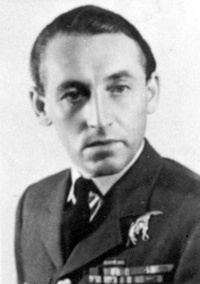Władysław Gnyś
Władysław Gnyś (24 August 1910 – 28 February 2000) was a Polish pilot of the Polish Air Force, a World War II flying ace and the first Polish victor in aerial combat in World War II.[1] He briefly served as the commander of No. 317 Polish Fighter Squadron; he was shot down on his first mission over France on August 27, 1944.
Władysław Gnyś | |
|---|---|
 | |
| Born | 24 August 1910 Sarnów, Russian Empire |
| Died | 28 February 2000 Beamsville, Canada |
| Buried | Mount Osborn Cemetery |
| Service/ | |
| Unit | |
| Awards | |
In 1931, Gnyś entered military service with the Polish Air Force. In 1933 he began air training in Grudziadz and later in 1936, was a flying instructor at the Polish Air Force Academy at Dęblin. During the war he scored six victories - three solo and three shared - in the Polish and French campaigns.
The defense of Poland, September 1939
By May 1939 Gnyś had been posted to the 121st Eskadra Mysliwska (121st Fighter Escadrille) in the city of Kraków, equipped with obsolete PZL P.11c fighters. On 31 August the Squadron was assigned to operate with the III/2 Dywizjon (Group) and it relocated to a reserve airfield in Balice.
In the early morning of 1 September 1939, Gnyś was woken by a German bombing raid on Kraków. At about 7 am (according to other sources, 5:30 am) Gnyś flew a sortie with Cpt Mieczyslaw Medwecki, the Group Commander. Just after take off and at about 300 meters altitude the Polish fighters were suddenly attacked by a pair of German Ju 87B dive-bombers from I/StG 2 "Immelmann". Unteroffizier Frank Neubert successfully fired at Medwecki and scored probably the first aerial victory of the war. The P-11 fell away having suffered serious damage, and Medwecki was killed. Gnyś was now also under attack, but later shot at a "Stuka" piloted by Lt. Brandenburg. The German aircraft started to smoke, but managed to return to base at Nieder-Ellguth. A few minutes later Gnyś attacked two Do 17E bombers from KG 77. After a few passes both Do 17 bombers crashed in the country village of Żurada, near Olkusz. One of the German bombers was coded "3Z+FR" on its fuselage and all six crew members were killed, one later identified as a Uffz. Klose. On his return to base Gnyś met a lone He 111, but he was out of ammunition.
There is controversy regarding these victories. According to Marius Emmerling, based on German wartime sources two Do 17Es from 7./KG 77 did crash near Żurada, but this was caused by a Polish anti-aircraft artillery, which damaged one Do 17 which then collided with the other. The Polish Aviation Museum in Kraków has the only surviving PZL P.11c fighter from the September campaign. Among other armaments, it has four 7.92 mm machine guns. An examination of a fragment from one of the downed Dorniers revealed at least four clearly defined bullet holes having the same diameter to the ammunition on board Gnyś's PZL P.11c fighter. Taking into account the bullets' angle of entry and the resulting damage, their diameters match up within one mm of the 7.92. This would conclude that the two Do 17s were not brought down by anti-aircraft fire because shrapnel from an exploding shell does not leave neat holes, but rather jagged and irregular size punctures.
The combat in which Medwecki was shot down took place in 5:30-6:00 am and, according to Emmerling, Gnyś only fired at the Ju 87, but did not hit it, nor did he meet Do 17s. Other authors however, claim that damage to one of the Do 17s which resulted in a collision with the other, might have been caused by Gnyś.[2] One such author, Polish aviation historian Jerzy B. Cynk, concluded that W. Gnyś was responsible for the first Allied aerial victories of the war. [see 'The Polish Air Force at War - The Official History 1939-1943' pp. 73, 75]
Gnyś scored another victory in September 1939, claiming a He 111.
France 1940
After the fall of Poland, Gnyś fled to France and served as a pilot with the French Air Force. Flying the Morane MS 406-C with GC III./1 and stationed at Toul Croix, Gnyś scored three shared victories; a He 111 on 12 May and two Do 17s on 16 May. After the French surrender, Gnyś escaped via Oran and Casablanca and arrived in Liverpool on 14 July 1940.
With the RAF 1940-44
Gnyś later fought with the Royal Air Force, joining No. 302 Squadron as a Pilot Officer on 17 August 1940 and seeing combat in the Battle of Britain and into 1941. On 21 May 1941 Gnyś' Hawker Hurricane was badly damaged by fighters although he managed to return to base.
Later he served with the No. 316 Polish Fighter Squadron flying Spitfires and No. 309 Polish Fighter-Reconnaissance Squadron, flying tactical reconnaissance Mustangs.
On 22 August 1944, he was appointed to the command of No. 317 Polish Fighter Squadron. Two days later, Gnyś was shot down over Rouen by flak, was wounded and captured by German forces. Despite his wounds, he escaped from a POW field hospital a few days later, found by the French Maquis and returned to the Allied lines safely.
He settled in Canada after the war.
Awards
![]()
![]()
![]()
![]()
References
- Kochanski, Halik (2012). The Eagle Unbowed: Poland and the Poles in the Second World War. Harvard University Press. p. 85. ISBN 0674068165.
- Marius Emmerling: Pierwszy zestrzał w kampanii wrześniowej 1939 r. - Mit ppor.pil. Władysława Gnysia in: Lotnictwo Wojskowe Nr.5/2002 (in Polish); Letters to editor in: Lotnictwo Wojskowe Nr.6/2002
Bibliography
Gnyś, Władek (1981). First Kill (Hardcover). William Kimber & Co Ltd. ISBN 0-7183-0397-0.
External links
Tyminski, Dariusz (8 October 1998). "First Allied Victory in WW2".